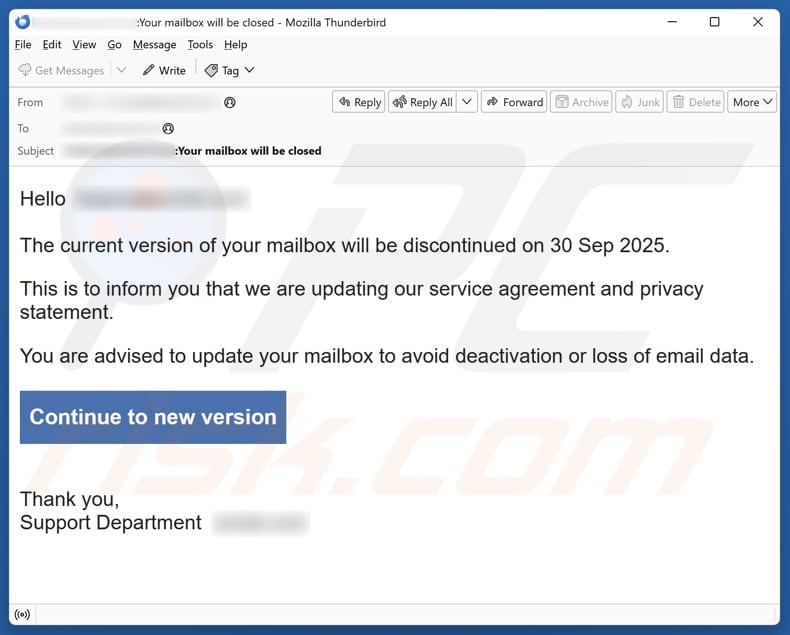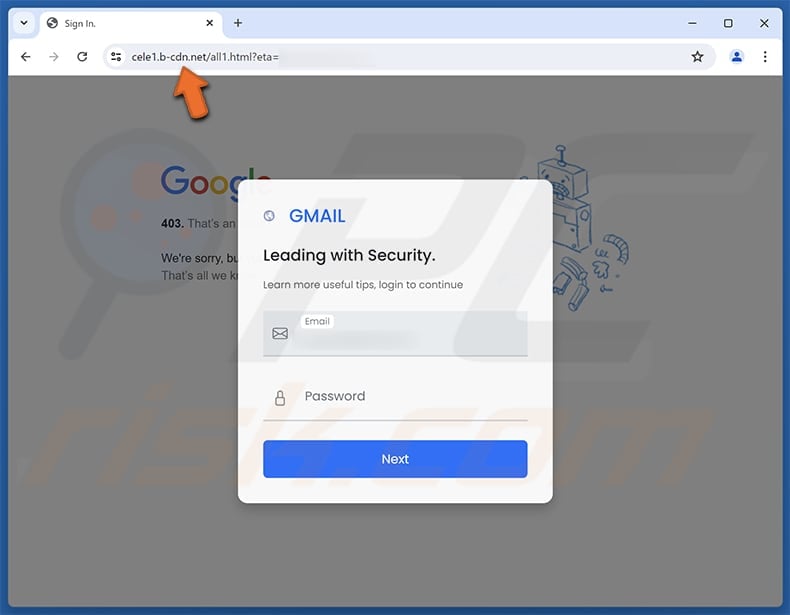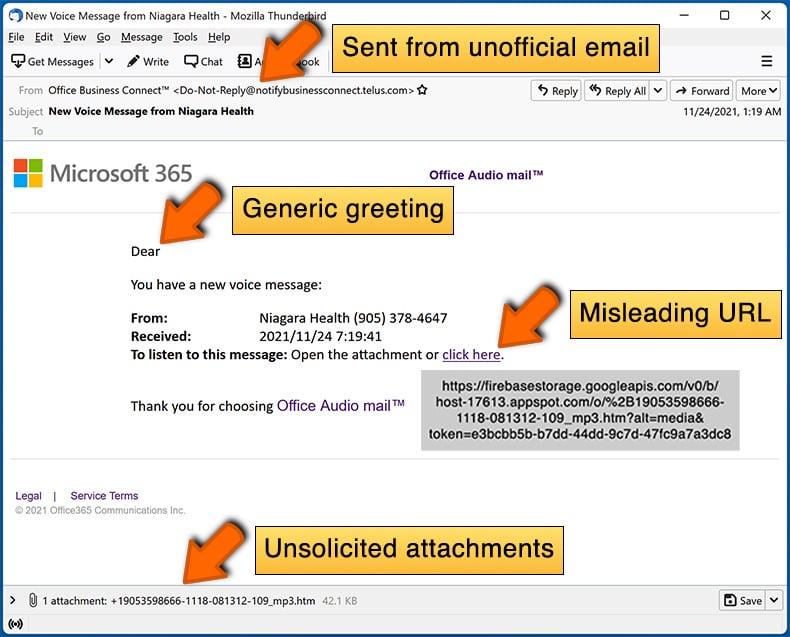How to identify scams like "Version Of Your Mailbox Will Be Discontinued"
Phishing/ScamAlso Known As: Version Of Your Mailbox Will Be Discontinued phishing scam
Get free scan and check if your device is infected.
Remove it nowTo use full-featured product, you have to purchase a license for Combo Cleaner. Seven days free trial available. Combo Cleaner is owned and operated by RCS LT, the parent company of PCRisk.com.
What kind of scam is "Version Of Your Mailbox Will Be Discontinued"?
Our analysis indicates that this is a fraudulent notification pretending to be from an email service provider. It contains a link to a fake website created to steal personal information. This type of scam is classified as a phishing attempt. Recipients should delete or ignore such emails to stay safe.

More about the "Version Of Your Mailbox Will Be Discontinued" scam email
The phishing email claims that the recipient's mailbox will be closed on the specified date. It states that the mailbox version is being discontinued and refers to updates to the service agreement and privacy statement. The message urges the recipient to update their mailbox to avoid deactivation or loss of email data and includes a button labeled "Continue to new version".
Clicking the button opens a fraudulent Gmail login page that instructs visitors to enter their email address and password. Any information entered on this page is not sent to Gmail but instead delivered directly to the scammers. With these stolen credentials, attackers can hijack email accounts.
Accessed accounts can be used to steal personal information, exploited to spread further phishing emails, deliver malware, impersonate the victim, and more. Scammers may also use the account to reset passwords for other linked services or try to access other accounts (e.g., social media or banking) using the login credentials that have already been stolen.
Thus, recipients should not trust such emails, never open the provided links, and enter personal information on websites shared through such messages.
| Name | Version Of Your Mailbox Will Be Discontinued Email Scam |
| Threat Type | Phishing, Scam, Social Engineering, Fraud |
| Fake Claim | Recipient's mailbox will be closed |
| Disguise | Notification from the email service provider |
| Related Domain | cele1.b-cdn[.]net |
| Detection Names (cele1.b-cdn[.]net) | N/A (VirusTotal) |
| Symptoms | Unauthorized online purchases, changed online account passwords, identity theft, illegal access of the computer. |
| Distribution methods | Deceptive emails, rogue online pop-up ads, search engine poisoning techniques, misspelled domains. |
| Damage | Loss of sensitive private information, monetary loss, identity theft. |
| Malware Removal (Windows) |
To eliminate possible malware infections, scan your computer with legitimate antivirus software. Our security researchers recommend using Combo Cleaner. Download Combo CleanerTo use full-featured product, you have to purchase a license for Combo Cleaner. 7 days free trial available. Combo Cleaner is owned and operated by RCS LT, the parent company of PCRisk.com. |
Similar scam emails in general
Phishing emails like this trick users into giving away their login details or other information through fake websites. Stolen information can be misused for fraud, identity theft, spreading scams, delivering malware, etc. Recipients are advised to never click suspicious links or enter personal information on untrusted sites to avoid falling for scams.
More examples of phishing emails are "Insufficient Storage Space", "WeTransfer - Received Transfer Expired", and "System Has Flagged Messages Due To Security Violations".
How do spam campaigns infect computers?
Cybercriminals can distribute malware via email attachments. These can include infected MS Office documents, PDFs, scripts, executable files, or compressed files like ZIPs and RARs. Simply opening these files, enabling functions like macros, or taking additional actions, can activate the malware and infect the system.
Malicious emails may also include links to fraudulent or compromised websites. Visiting these sites can automatically download malware or trick users into manually downloading and running harmful programs.
How to avoid installation of malware?
Be suspicious of messages (including emails) from unknown senders. Avoid opening attachments or clicking links in such messages. Keep your antivirus (and the operating system and installed apps) up to date and run regular system scans. Be cautious on unfamiliar websites - do not trust ads, pop-ups, and other content on them.
Also, avoid allowing shady sites to send notifications and download software from official websites or trusted app stores.
Text presented in the "Version Of Your Mailbox Will Be Discontinued" email letter:
Subject: [********]:Your mailbox will be closed
Hello ********
The current version of your mailbox will be discontinued on 30 Sep 2025.
This is to inform you that we are updating our service agreement and privacy statement.
You are advised to update your mailbox to avoid deactivation or loss of email data.
Continue to new version
Thank you,
Support Department ********
Phishing page used in this scam:

Instant automatic malware removal:
Manual threat removal might be a lengthy and complicated process that requires advanced IT skills. Combo Cleaner is a professional automatic malware removal tool that is recommended to get rid of malware. Download it by clicking the button below:
DOWNLOAD Combo CleanerBy downloading any software listed on this website you agree to our Privacy Policy and Terms of Use. To use full-featured product, you have to purchase a license for Combo Cleaner. 7 days free trial available. Combo Cleaner is owned and operated by RCS LT, the parent company of PCRisk.com.
Quick menu:
- What is Version Of Your Mailbox Will Be Discontinued phishing scam?
- Types of malicious emails.
- How to spot a malicious email?
- What to do if you fell for an email scam?
Types of malicious emails:
![]() Phishing Emails
Phishing Emails
Most commonly, cybercriminals use deceptive emails to trick Internet users into giving away their sensitive private information, for example, login information for various online services, email accounts, or online banking information.
Such attacks are called phishing. In a phishing attack, cybercriminals usually send an email message with some popular service logo (for example, Microsoft, DHL, Amazon, Netflix), create urgency (wrong shipping address, expired password, etc.), and place a link which they hope their potential victims will click on.
After clicking the link presented in such email message, victims are redirected to a fake website that looks identical or extremely similar to the original one. Victims are then asked to enter their password, credit card details, or some other information that gets stolen by cybercriminals.
![]() Emails with Malicious Attachments
Emails with Malicious Attachments
Another popular attack vector is email spam with malicious attachments that infect users' computers with malware. Malicious attachments usually carry trojans that are capable of stealing passwords, banking information, and other sensitive information.
In such attacks, cybercriminals' main goal is to trick their potential victims into opening an infected email attachment. To achieve this goal, email messages usually talk about recently received invoices, faxes, or voice messages.
If a potential victim falls for the lure and opens the attachment, their computers get infected, and cybercriminals can collect a lot of sensitive information.
While it's a more complicated method to steal personal information (spam filters and antivirus programs usually detect such attempts), if successful, cybercriminals can get a much wider array of data and can collect information for a long period of time.
![]() Sextortion Emails
Sextortion Emails
This is a type of phishing. In this case, users receive an email claiming that a cybercriminal could access the webcam of the potential victim and has a video recording of one's masturbation.
To get rid of the video, victims are asked to pay a ransom (usually using Bitcoin or another cryptocurrency). Nevertheless, all of these claims are false - users who receive such emails should ignore and delete them.
How to spot a malicious email?
While cyber criminals try to make their lure emails look trustworthy, here are some things that you should look for when trying to spot a phishing email:
- Check the sender's ("from") email address: Hover your mouse over the "from" address and check if it's legitimate. For example, if you received an email from Microsoft, be sure to check if the email address is @microsoft.com and not something suspicious like @m1crosoft.com, @microsfot.com, @account-security-noreply.com, etc.
- Check for generic greetings: If the greeting in the email is "Dear user", "Dear @youremail.com", "Dear valued customer", this should raise suspiciousness. Most commonly, companies call you by your name. Lack of this information could signal a phishing attempt.
- Check the links in the email: Hover your mouse over the link presented in the email, if the link that appears seems suspicious, don't click it. For example, if you received an email from Microsoft and the link in the email shows that it will go to firebasestorage.googleapis.com/v0... you shouldn't trust it. It's best not to click any links in the emails but to visit the company website that sent you the email in the first place.
- Don't blindly trust email attachments: Most commonly, legitimate companies will ask you to log in to their website and to view any documents there; if you received an email with an attachment, it's a good idea to scan it with an antivirus application. Infected email attachments are a common attack vector used by cybercriminals.
To minimise the risk of opening phishing and malicious emails we recommend using Combo Cleaner Antivirus for Windows.
Example of a spam email:

What to do if you fell for an email scam?
- If you clicked on a link in a phishing email and entered your password - be sure to change your password as soon as possible. Usually, cybercriminals collect stolen credentials and then sell them to other groups that use them for malicious purposes. If you change your password in a timely manner, there's a chance that criminals won't have enough time to do any damage.
- If you entered your credit card information - contact your bank as soon as possible and explain the situation. There's a good chance that you will need to cancel your compromised credit card and get a new one.
- If you see any signs of identity theft - you should immediately contact the Federal Trade Commission. This institution will collect information about your situation and create a personal recovery plan.
- If you opened a malicious attachment - your computer is probably infected, you should scan it with a reputable antivirus application. For this purpose, we recommend using Combo Cleaner Antivirus for Windows.
- Help other Internet users - report phishing emails to Anti-Phishing Working Group, FBI’s Internet Crime Complaint Center, National Fraud Information Center and U.S. Department of Justice.
Frequently Asked Questions (FAQ)
Why did I receive this email?
Your email address was probably obtained through a data leak or an unsafe website. Messages of this type are usually distributed to large lists of addresses rather than being individually targeted.
I have provided my personal information when tricked by this email, what should I do?
If login credentials were disclosed, all associated passwords should be changed immediately. In cases where sensitive personal data (e.g., payment details or identification information) was provided, the relevant authorities must be notified.
I have downloaded and opened a malicious file attached to an email, is my computer infected?
Computer infections commonly result from user interaction with malicious files. This can include executing harmful programs or activating macros in compromised Office documents. The exact effect depends on the type of file opened.
I have read the email but did not open the attachment, is my computer infected?
Viewing an email alone does not compromise a device. Infection occurs only if the recipient interacts with harmful links or attachments.
Will Combo Cleaner remove malware infections that were present in email attachment?
While Combo Cleaner is effective at detecting and removing most known malware, certain advanced threats may be more deeply embedded. Performing a full system scan is essential to ensure removal.
Share:

Tomas Meskauskas
Expert security researcher, professional malware analyst
I am passionate about computer security and technology. I have an experience of over 10 years working in various companies related to computer technical issue solving and Internet security. I have been working as an author and editor for pcrisk.com since 2010. Follow me on Twitter and LinkedIn to stay informed about the latest online security threats.
PCrisk security portal is brought by a company RCS LT.
Joined forces of security researchers help educate computer users about the latest online security threats. More information about the company RCS LT.
Our malware removal guides are free. However, if you want to support us you can send us a donation.
DonatePCrisk security portal is brought by a company RCS LT.
Joined forces of security researchers help educate computer users about the latest online security threats. More information about the company RCS LT.
Our malware removal guides are free. However, if you want to support us you can send us a donation.
Donate
▼ Show Discussion